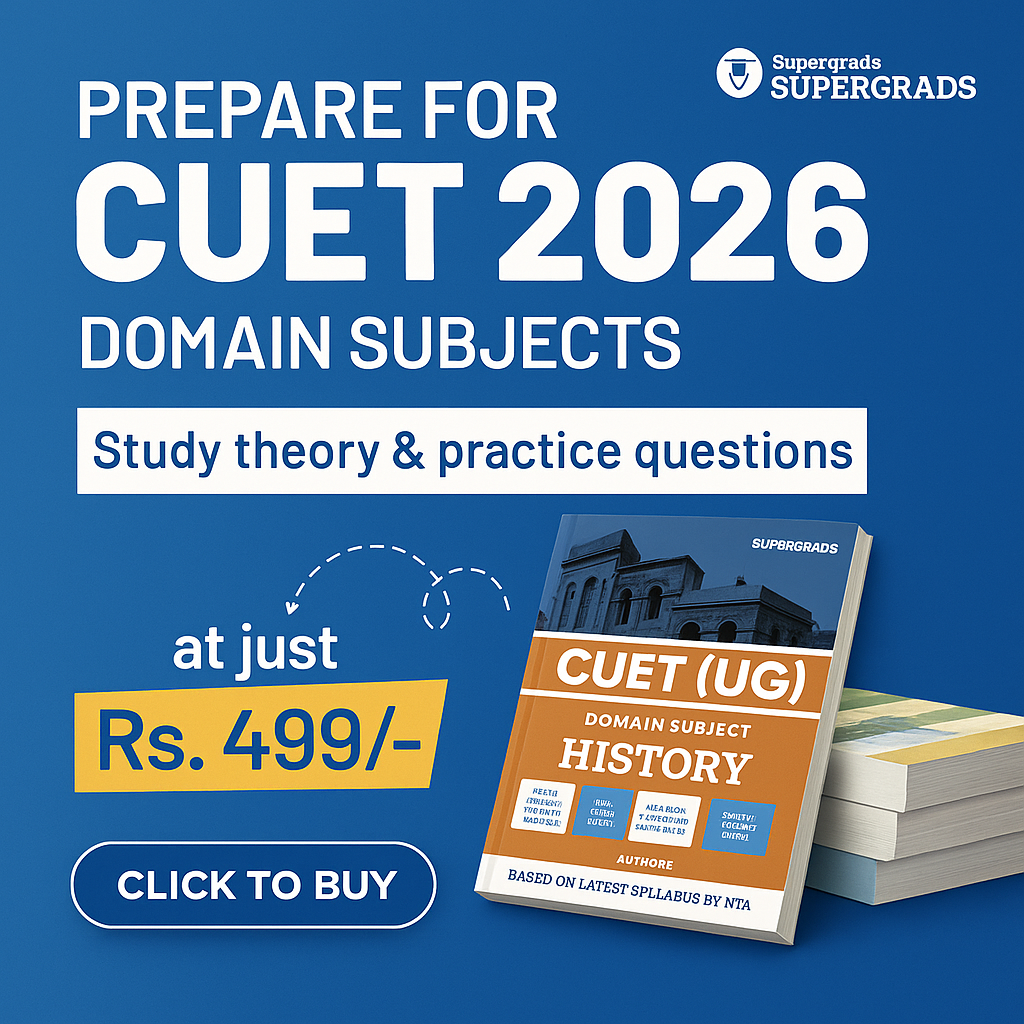CUET Physics Syllabus 2026: Check Detailed Syllabus Topics
November 29, 2025
Overview: Physics is a core science subject that covers a broad range of topics, including mechanics, light, heat, sound, radiation, magnetism, electricity, and atomic structure. Before preparing for the Physics stream courses, review the CUET Physics syllabus 2026 to score 100% in the exam.
To pursue your desired Science or Engineering UG course, such as B.Sc, B.Sc Honours, etc, from one of the 280+ universities through CUET, be well-versed with the CUET Physics Syllabus 2026.
- Instead of 10 units, now you have to prepare only 9 main units in the CUET syllabus for Physics.
- There is a maximum score of 250; you will lose one mark for every incorrect response.
What is the CUET Physics Syllabus for 2026?
The Physics syllabus for CUET exam includes 9 units, ranging from Electrostatics to Magnetism to Atoms and nuclei. The overall difficulty level of the exam is challenging with more numerical-based questions per the previous year's CUET exam analysis for Physics.
CUET Physics Syllabus PDF Download Link 2026
Click on the button below to download the CUET exam Physics syllabus:
Detailed CUET Physics Syllabus 2026 [Unit-Wise]
Unit I: Electrostatics
- Charges for electricity and its conservation. Coulomb's law - force between two point charges, the force between numerous charges, the superposition principle, and continuous charge distribution.
- Electric field, electric field resulting from a point charge, electric field lines; electric dipole, electric field resulting from a dipole; dipole torque in a uniform electric field.
- Electric flux, formulation of Gauss's theorem, and its applications to determine the field due to an indefinitely long straight wire, an infinitely charged plane sheet, and an infinitely charged thin spherical shell (field inside and outside).
- Electric potential, potential difference, the electric potential resulting from a point charge, dipole, and system of charges; equipotential surfaces, the electrical potential energy of a system of two point charges; and electric dipoles in an electrostatic field.
- Conductors, insulators, free & bound charges found within a conductor, Dielectrics and electric polarization, capacitors, capacitance, series and parallel combinations of capacitors, the capacitance of a parallel plate capacitor with and without dielectric material between the plates, energy stored in a capacitor, Van de Graaff generator.
Review the CUET previous year question papers and trends to identify the topics with higher weightage. Before deciding which topics to leave out in the CUET Physics Syllabus, check those areas' marks allocation or importance.
Unit II: Electrical Current
- Electric current, electric charge flow in a metallic conductor, drift velocity and mobility, and their relationship to an electric current; Ohm's law, electrical resistance, V-I characteristics (linear and non-linear), electrical energy and power, electrical resistivity and conductivity.
- Carbon resistors, colour coding for carbon resistors, series and parallel combinations of resistors, resistance temperature dependency.
- Internal resistance, potential difference, and electromotive force of a cell, series, and parallel cell combinations.
- The laws of Kirchhoff and their straightforward applications. Wheatstone bridge, meter bridge.
- Principle and applications of the potentiometer for measuring potential difference and comparing the electromotive forces of two cells; measurement of the internal resistance of a cell.
Unit III: Magnetic Effects of Current and Magnetism
Use SuperGrads expert-recommended CUET Preparation Books 2026 and study materials that cover the entire CUET Physics syllabus.
- The magnetic field concept and Oersted's experiment. The application of the Biot-Savart law to a current-carrying circular loop.
- The application of Ampere's law to indefinitely long straight wires and straight and toroidal solenoids. Force exerted on a moving charge in magnetic and electric fields of uniform uniformity. Cyclotron.
- The force exerted on a conductor carrying a current in a uniform magnetic field. The force exerted by parallel currents
- Transporting conductors – ampere's definition. A current loop in a magnetic field, the current sensitivity, and the conversion of a moving coil galvanometer to an ammeter and voltmeter experience torque.
- The current loop is shown as a magnetic dipole and its magnetic dipole moment. The magnetic dipole moment of an electron that is rotating. Magnetic field strength is along and perpendicular to a magnetic dipole's axis (bar magnet). Torque on a magnetic dipole (bar magnet) in a homogenous magnetic field; bar magnet as an analogous solenoid, magnetic field lines; Earth's magnetic field and magnetic components. It is one of the suggested CUET Physics important topics 2026.
- Examples of para-, dia-, and ferromagnetic compounds, electromagnets and the factors influencing their strengths. Permanent magnets.
Unit IV: Electromagnetic Induction and Alternating Currents
- Magnetic induction; Faraday's law; induced emf and current; Lenz's law; Eddy currents. Individual and mutual induction.
- Alternating currents, peak and RMS value of alternating current/voltage; reactance and impedance; LC oscillations (qualitative treatment only), LCR series circuit, resonance; AC power, wattless current. AC generator and transformer.
Unit V: Electromagnetic Waves
Regular revision is essential for retaining what you have learned. Review the main concepts and formulas in the CUET Physics syllabus frequently, especially before the exam, to score 250/250 and secure admission in your desired Science & Engineering CUET courses.
- The requirement for displacement current. Electromagnetic radiation and its properties (qualitative ideas only). The longitudinal character of electromagnetic waves.
- The electromagnetic spectrum (radio waves, microwaves, infrared, visible, ultraviolet, x-rays, and gamma rays) and basic information regarding its applications.
Section VI: Optics
Follow a systematic CUET study plan for enhanced learning and understanding of topics. Choose the right books to cover each unit of the CUET physics syllabus. Prepare from books with chapter-wise practice questions, sample papers and unit-wise CUET mock tests. This will help you cover each unit effectively.
- Light reflection, spherical mirrors, and the mirror formula. Refraction of light, total internal reflection and its uses, optical fibres, refraction at spherical surfaces, lenses, the formula for the thin lens, and a formula for lens maker. Magnification, lens power, and combining thin lenses in contact with a lens and a mirror create a contact lens. Light's refraction and dispersion through a prism.
- The dispersion of the sky's blue hue and the reddish look of the sun during sunrise and dusk.
- Optical instruments: Human eye, image production and accommodation, lens-based treatment of visual abnormalities (myopia and hyperopia).
- Microscopes and (reflecting and refracting) astronomical telescopes and their magnification powers.
- Optics and waves Using wavefronts to explain Huygens' principle, reflection, and refraction of a plane wave at a flat surface.
- The rules of reflection and refraction are demonstrated using Huygens' concept.
- Interference, Young's double-hole experiment, and the equation for fringe width, coherent sources, and persistent light interference.
- A single slit, central maximum width cause diffraction.
- Understanding the capabilities of microscopes and astronomy telescopes Polarisation, plane polarised light, Brewster's law, plane polarised light applications and Polaroids.
Unit VII: The Dual Nature of Matter and Radiation
- The photoelectric effect, the observations of Hertz and Lenard, and Einstein's photoelectric equation – the particle nature of light.
- Matter waves - particle-wave nature, de Broglie connection. Davisson-Germer investigation (experimental details should be omitted; only the conclusion should be explained.)
Unit VIII: Atoms and Nuclei
This is one of the simple and easy-to-understand topics. It takes minimal effort to learn and less time to cover every CUET Physics important questions asked from this unit.
- Alpha-particle scattering experiment; Rutherford's atomic model; the Bohr model, energy levels, and the hydrogen spectrum. Nucleus composition, size, atomic masses, isotopes, and isobars.
- The properties of alpha, beta, and gamma particles/rays; the law of radioactive decay. The relationship between mass and energy, mass defect, binding energy per nucleon and its dependence on nucleon number, nuclear fission and fusion.
Unit IX: Electronic Devices
- Energy bands in solids (qualitative ideas only), conductors, insulators and semiconductors; semiconductor diode – I-V characteristics in forward and reverse bias, diode as a rectifier.
- Transistor junction, transistor action, and transistor characteristics; the transistor as an amplifier (common emitter configuration) and oscillator.
What is the Exam Pattern for CUET Physics 2026?
Now that you know the CUET Physics syllabus, you must know the test paper pattern too to have a clear understanding of your marks will be calculated.
Of 23 domain subjects in the CUET exam, Physics is a highly popular subject due to its requirement in participating universities' Science UG courses.
The exam pattern for Physics is mentioned below:
| Particulars | Details |
|---|---|
| CUET Exam Conducting Body | National Testing Agency (NTA) |
| Medium of Exam | 13 languages - English, Hindi, Urdu, Assamese, Bengali, Odia, Punjabi, Gujarati, Marathi, Tamil, Telugu, Kannada, Malayalam |
| Number of questions | 50 questions must be attempted |
| Type of questions | Objective Type (Multiple Choice Questions) |
| Total Marks | 250 |
| Exam Duration | 60 minutes |
The CUET Marking Scheme for Physics is listed below:
- Unanswered/ unattempted question: No mark
- Correct Answer: +5
- Incorrect Answer: -1
Top Tips to Prepare for CUET Physics Syllabus 2026
Below are tips on how to prepare Physics CUET syllabus to boost your exam preparation:
- Understanding Concepts: Focus on grasping fundamental concepts from NCERT textbooks.
- Practice Regularly: Solve previous year's papers and sample questions from the CUET physics syllabus to build accuracy and speed.
- Time Management: Develop a strategy to allocate time to each section during the exam efficiently.
- Focus on important topics and questions: First, focus on high-weightage topics and questions from the physics syllabus CUET and then move on to other units.
Best Books for CUET Physics Syllabus Preparation 2026
The recommended books that you can use for your CUET preparation of the Physics syllabus are:
| CUET Preparation Books 2026 | Author |
| Concept of Physics Vol 1 & 2 | H.C. Verma |
| Understanding Physics (Set of 5 books) | D.C. Pandey |
| Fundamentals of Physics | Halliday, Resnick, and Walker |
| CUET Rankers Study Material | Supergrads |
| Class XII Physics Textbook | NCERT |
Check: CUET Physics Notes 2026
Key Takeaways
The CUET Physics Syllabus 2026 offers a comprehensive and well-structured framework for excelling in the exam while simultaneously preparing for the board exams.
- By focusing on the 9 key units based on class 11th and 12th NCERT textbooks, you can efficiently align your study strategies for both exams.
- The CUET physics syllabus emphasises a wide range of topics from electrostatics to communication systems; thus, it requires thorough preparation.
- Create a structured study plan and stick to it.
- Avoid last-minute cramming and focus on the conceptual clarity of the physics syllabus for CUET.
- Attempt 10-12 full-length mock tests from Supergrads CUET Online Coaching to understand the exam pattern and identify areas for improvement
- Stay calm and consistent during your preparation to score well in the exam.
Frequently Asked Questions
How many units do I prepare for CUET Physics Syllabus 2026?

Which is the best book to prepare for CUET UG Physics Syllabus 2026?

Where can I download the CUET Physics syllabus PDF?

Does the Physics CUET syllabus include modern physics topics?

What are some high-weightage topics in the CUET Physics syllabus?

Is the CUET Physics syllabus difficult?



1732085540.webp)




SHARE